Do you have a question about the MELAG Vacuklav 41 B+ Evolution and is the answer not in the manual?
Explains symbols used in the manual for clarity and safety.
Outlines conventions for text and references within the document.
Describes the mobile app for monitoring device status and progress.
Specifies that only competent personnel should operate the sterilizer.
Details requirements for safe device installation and initial operation.
Provides safety instructions for handling the power cord and plug.
Emphasizes ensuring the proper function of the safety valve.
Guides on following manufacturer instructions for instruments and textiles.
Warns about steam emission and potential unsterility after program abort.
Advises on safe handling of hot equipment and checking packaging.
Outlines precautions for moving and storing the device safely.
Stresses that maintenance must be done by authorized technicians.
Advises turning off the device for repeated malfunctions.
Mandates reporting serious accidents involving the medical product.
Defines the device's purpose and application in medical contexts.
Explains the fractionated vacuum procedure for steam sterilization.
Describes the one-way feed water system and its quality monitoring.
Details internal process monitoring and door mechanism safety features.
Summarizes compliance of different programs with EN 13060 standards.
Details the phases of a standard sterilization program and vacuum test.
Lists all items included in the standard package for the device.
Provides detailed diagrams and labels for front and rear views.
Explains the procedure for opening and closing the service hatch.
Identifies and explains various symbols found on the device itself.
Describes how to fix and use mounts for various load holders.
Explains activation and deactivation of the energy-saving mode.
Details the interface elements of the 5-inch colour touch display.
Explains the meaning of different LED colours on the status bar.
Notes compliance with technical manual for building-side requirements.
Describes the process for documenting installation and commissioning.
Covers requirements for distilled/demineralized water and connections.
Explains how to fill and use the internal water storage tank.
Guides on powering on the device and initial screen interaction.
Details the automatic door locking mechanism and safe operation.
Provides instructions for securely closing the door and engaging the lock.
Explains the procedure for manually opening the door in emergencies.
Emphasizes cleaning, disinfection, and drying of instruments and textiles.
Provides detailed steps for instrument preparation and warnings.
Outlines procedures for textile preparation and warnings about improper handling.
Gives instructions for correct loading to ensure effective sterilization and drying.
Specifies requirements for packaging materials and systems.
Explains how to use closed containers for optimal results.
Provides guidance on using soft packaging materials like MELAfol.
Explains the use of multiple wrapping layers for sterilization.
Offers advice on arranging mixed loads for proper sterilization.
Highlights compliance with RKI and DIN standards for daily checks.
Provides a table for necessary checks and their frequency.
Guides on choosing the correct program based on material and packaging.
Lists and describes optional programs like Vacuum test and Bowie & Dick test.
Explains options like additional drying and start time pre-selection.
Details how to schedule program start times.
Instructs on initiating a sterilization program, including user authentication.
Describes the program phases and how to monitor progress.
Explains remote monitoring of the program via a web browser.
Details how to cancel a program and the implications.
Warns about unsterile loads if drying is interrupted early.
Advises on aborting during drying and potential issues.
Describes successful program completion and viewing results.
Explains the batch indication and approval process requiring user authentication.
Provides safety guidelines for unloading sterilized items.
Offers recommendations for proper storage of sterile items.
Explains the importance of batch documentation for quality assurance.
Lists available media for outputting logs (CF card, printer, computer).
Details how to insert and use a CF card for log storage.
Guides on connecting the sterilizer to a computer for log transfer.
Explains how to open and view log files on a PC.
Describes using a label printer for batch traceability.
Covers automatic log output upon program completion.
Explains how to output logs manually after the program has ended.
Details how to select and output specific logs from the memory.
Provides steps for outputting logs by specific timeframes.
Guides on locating and storing logs on memory media.
Describes where log files are stored on CF cards and computers.
Explains the folder structure for log files.
Shows a sample log entry with explanations of its fields.
Mentions following program runs and using logs for success determination.
Explains how to perform a vacuum test to check for leakages.
Details the Bowie & Dick test for steam penetration assurance.
Guides on interpreting the results of the Bowie & Dick test indicator.
Covers settings for text/graphic log output, medium, and format.
Explains how to activate or deactivate automatic log output.
Details steps to disable immediate log output.
Describes how to enable graphic log output.
Guides on setting the log printer language to English.
Explains network connection for log transfer to computer.
Details FTP connection settings for computer output.
Details TCP connection settings for computer output.
Lists default IP addresses for device network integration.
Explains different formats for outputting log data.
Covers setting up user IDs and PINs for authentication.
Details the process of creating new user accounts.
Explains how to remove user accounts.
Guides on changing the administrator password.
Explains options for requiring user PIN for operations.
Details settings for user authentication requirements.
Guides on formatting the CF card, including data loss warning.
Explains activating/deactivating additional drying features.
Describes the intelligent drying process.
Covers selecting internal or external water supply sources.
Guides on setting the device's date and time accurately.
Explains how to adjust display brightness and contrast.
Details how to adjust the device's audio volume.
Allows selection between classic and modern interface views.
Explains changing the interface from modern to classic view.
Explains changing the interface from classic to modern view.
Guides on connecting the sterilizer to the mobile app.
Explains how to enable or disable key press tones.
Covers activating the screensaver and selecting images.
Details how to choose pictures for the screensaver.
Explains setting display timing for the screensaver.
Allows adjustment of touchscreen sensitivity.
Explains how to activate and configure energy-saving settings.
Guides on configuring the display to switch off automatically.
Lists recommended maintenance tasks and their frequency.
Provides general cleaning advice and warnings about damage.
Details weekly checks and cleaning of these components.
Explains how to clean external housing parts.
Covers checks and cleaning for the internal water storage tank.
Provides step-by-step instructions to drain the storage tank.
Details cleaning procedures for the water tank's feed and waste sides.
Explains how to prevent staining caused by instrument decontamination.
Guides on lubricating the door spindle every two months.
Stresses timely maintenance by authorized technicians and its importance.
Notes that chamber temperature is maintained between programs.
Outlines measures for different pause durations to save energy or maintain device.
Provides steps for preparing the sterilizer for long periods of inactivity.
Explains how to drain the double jacket steam generator.
Gives safety precautions for moving the device.
Details safe transport procedures within the facility.
Mentions preparation for external transport.
Refers to the technical manual for recommissioning after a move.
Explains informational messages that support operation.
Describes warning messages that help prevent issues.
Details error messages indicating unsafe operation or sterilization failure.
Guides on transferring malfunction messages to a mobile device.
Provides detailed troubleshooting for specific error codes.
Explains symbols used in the manual for clarity and safety.
Outlines conventions for text and references within the document.
Describes the mobile app for monitoring device status and progress.
Specifies that only competent personnel should operate the sterilizer.
Details requirements for safe device installation and initial operation.
Provides safety instructions for handling the power cord and plug.
Emphasizes ensuring the proper function of the safety valve.
Guides on following manufacturer instructions for instruments and textiles.
Warns about steam emission and potential unsterility after program abort.
Advises on safe handling of hot equipment and checking packaging.
Outlines precautions for moving and storing the device safely.
Stresses that maintenance must be done by authorized technicians.
Advises turning off the device for repeated malfunctions.
Mandates reporting serious accidents involving the medical product.
Defines the device's purpose and application in medical contexts.
Explains the fractionated vacuum procedure for steam sterilization.
Describes the one-way feed water system and its quality monitoring.
Details internal process monitoring and door mechanism safety features.
Summarizes compliance of different programs with EN 13060 standards.
Details the phases of a standard sterilization program and vacuum test.
Lists all items included in the standard package for the device.
Provides detailed diagrams and labels for front and rear views.
Explains the procedure for opening and closing the service hatch.
Identifies and explains various symbols found on the device itself.
Describes how to fix and use mounts for various load holders.
Explains activation and deactivation of the energy-saving mode.
Details the interface elements of the 5-inch colour touch display.
Explains the meaning of different LED colours on the status bar.
Notes compliance with technical manual for building-side requirements.
Describes the process for documenting installation and commissioning.
Covers requirements for distilled/demineralized water and connections.
Explains how to fill and use the internal water storage tank.
Guides on powering on the device and initial screen interaction.
Details the automatic door locking mechanism and safe operation.
Provides instructions for securely closing the door and engaging the lock.
Explains the procedure for manually opening the door in emergencies.
Emphasizes cleaning, disinfection, and drying of instruments and textiles.
Provides detailed steps for instrument preparation and warnings.
Outlines procedures for textile preparation and warnings about improper handling.
Gives instructions for correct loading to ensure effective sterilization and drying.
Specifies requirements for packaging materials and systems.
Explains how to use closed containers for optimal results.
Provides guidance on using soft packaging materials like MELAfol.
Explains the use of multiple wrapping layers for sterilization.
Offers advice on arranging mixed loads for proper sterilization.
Highlights compliance with RKI and DIN standards for daily checks.
Provides a table for necessary checks and their frequency.
Guides on choosing the correct program based on material and packaging.
Lists and describes optional programs like Vacuum test and Bowie & Dick test.
Explains options like additional drying and start time pre-selection.
Details how to schedule program start times.
Instructs on initiating a sterilization program, including user authentication.
Describes the program phases and how to monitor progress.
Explains remote monitoring of the program via a web browser.
Details how to cancel a program and the implications.
Warns about unsterile loads if drying is interrupted early.
Advises on aborting during drying and potential issues.
Describes successful program completion and viewing results.
Explains the batch indication and approval process requiring user authentication.
Provides safety guidelines for unloading sterilized items.
Offers recommendations for proper storage of sterile items.
Explains the importance of batch documentation for quality assurance.
Lists available media for outputting logs (CF card, printer, computer).
Details how to insert and use a CF card for log storage.
Guides on connecting the sterilizer to a computer for log transfer.
Explains how to open and view log files on a PC.
Describes using a label printer for batch traceability.
Covers automatic log output upon program completion.
Explains how to output logs manually after the program has ended.
Details how to select and output specific logs from the memory.
Provides steps for outputting logs by specific timeframes.
Guides on locating and storing logs on memory media.
Describes where log files are stored on CF cards and computers.
Explains the folder structure for log files.
Shows a sample log entry with explanations of its fields.
Mentions following program runs and using logs for success determination.
Explains how to perform a vacuum test to check for leakages.
Details the Bowie & Dick test for steam penetration assurance.
Guides on interpreting the results of the Bowie & Dick test indicator.
Covers settings for text/graphic log output, medium, and format.
Explains how to activate or deactivate automatic log output.
Details steps to disable immediate log output.
Describes how to enable graphic log output.
Guides on setting the log printer language to English.
Explains network connection for log transfer to computer.
Details FTP connection settings for computer output.
Details TCP connection settings for computer output.
Lists default IP addresses for device network integration.
Explains different formats for outputting log data.
Covers setting up user IDs and PINs for authentication.
Details the process of creating new user accounts.
Explains how to remove user accounts.
Guides on changing the administrator password.
Explains options for requiring user PIN for operations.
Details settings for user authentication requirements.
Guides on formatting the CF card, including data loss warning.
Explains activating/deactivating additional drying features.
Describes the intelligent drying process.
Covers selecting internal or external water supply sources.
Guides on setting the device's date and time accurately.
Explains how to adjust display brightness and contrast.
Details how to adjust the device's audio volume.
Allows selection between classic and modern interface views.
Explains changing the interface from modern to classic view.
Explains changing the interface from classic to modern view.
Guides on connecting the sterilizer to the mobile app.
Explains how to enable or disable key press tones.
Covers activating the screensaver and selecting images.
Details how to choose pictures for the screensaver.
Explains setting display timing for the screensaver.
Allows adjustment of touchscreen sensitivity.
Explains how to activate and configure energy-saving settings.
Guides on configuring the display to switch off automatically.
Lists recommended maintenance tasks and their frequency.
Provides general cleaning advice and warnings about damage.
Details weekly checks and cleaning of these components.
Explains how to clean external housing parts.
Covers checks and cleaning for the internal water storage tank.
Provides step-by-step instructions to drain the storage tank.
Details cleaning procedures for the water tank's feed and waste sides.
Explains how to prevent staining caused by instrument decontamination.
Guides on lubricating the door spindle every two months.
Stresses timely maintenance by authorized technicians and its importance.
Notes that chamber temperature is maintained between programs.
Outlines measures for different pause durations to save energy or maintain device.
Provides steps for preparing the sterilizer for long periods of inactivity.
Explains how to drain the double jacket steam generator.
Gives safety precautions for moving the device.
Details safe transport procedures within the facility.
Mentions preparation for external transport.
Refers to the technical manual for recommissioning after a move.
Explains informational messages that support operation.
Describes warning messages that help prevent issues.
Details error messages indicating unsafe operation or sterilization failure.
Guides on transferring malfunction messages to a mobile device.
Provides detailed troubleshooting for specific error codes.
| Chamber Volume | 23 liters |
|---|---|
| Material | Stainless steel |
| Type | Autoclave |
| Sterilization Temperature Range | 121°C to 134°C |
| Sterilization Time Range | 3 to 60 minutes |
| Power Supply | 230 V / 50-60 Hz |
| Power Consumption | 2.5 kW |
| Programs | Test programs |
| Control | Microprocessor |
| Display | LCD |
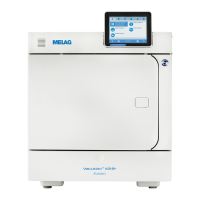
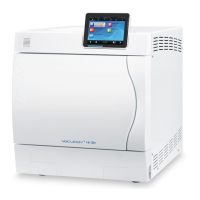
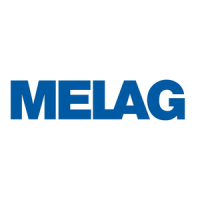
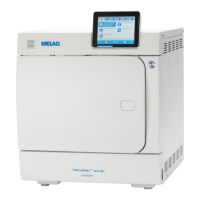

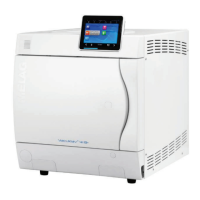
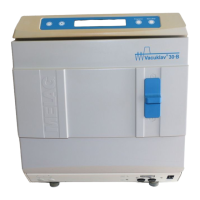
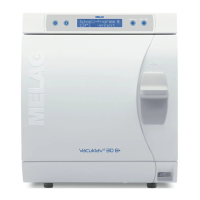
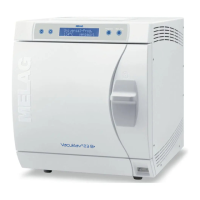

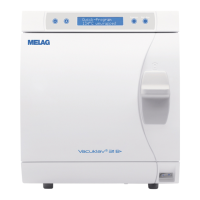

